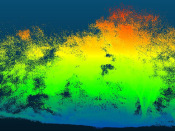Por Raquel Menezes (Departamento de Matemática - Universidade do Minho).
Environmental monitoring data often have both a spatial structure, determined by the locations of monitors, and a temporal one, determined by the frequency with which observations are taken at these locations. Advances in technology have made the collection of datasets with this structure increasingly common in a wide variety of settings.
As a motivating example, we shall consider NO2 data collected in Portugal mainland, with different time resolutions. NO2 is classified as a primary pollutant, for the estimation of the air quality index, whose excessive presence may cause significant environmental and health problems. Daily measurements along nine years are first considered, aiming to understand seasonal patterns and to identify relevant spatial covariates, such as type of site and type of environment (Menezes et al., 2016). Then, aiming to capture intra- and inter-day patterns imposed by social habits, we consider hourly data measured in those months when pollution levels are higher (Monteiro et al., 2017). The importance of meteorological variables, such as temperature, wind speed and relative humidity, is also investigated.
We present an easily implementable 2-stepwise approach to model spatio-temporal data. Firstly, we adopt a generalized linear model dependent on the data distribution to approximate the trend, by relaxing the assumption of non-correlated errors, which provides point estimates of the regression parameters. Then, to fully accomplish the estimation of the spatio-temporal correlation among data, a valid space-time semivariogram can be fit to the residuals, by considering the trend as deterministic. This 2-stepwise approach aims to estimate separately the large-scale variation and the small-scale variation of the spatio-temporal stochastic process.
Furthermore, we recommend to apply bootstrap methods to obtain accuracy measures of all the parameters estimates involved in the 2-stepwise modelling procedure. In particular, the standard errors for the regression coefficients of the trend might be acquired through a parametric bootstrap. Alternatively, a block bootstrap procedure can be adopted to correctly assess uncertainty of parameters estimates, as well as to produce reliable confidence regions for (space-time) NO2 concentrations.










